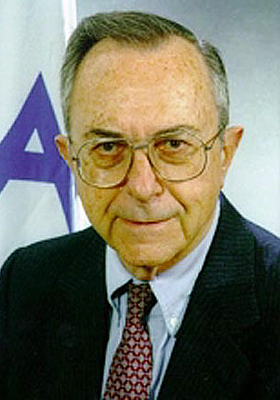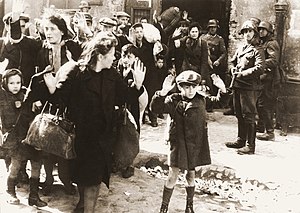Additional Perspective
Yesterday I wrote about Holocaust remembrance. Today I want to expand on this, for the day being observed right now is most properly called Yom Hashoah v'Hagvurah -- Day of Remembrance of the Holocaust and the Heroism. That second part is important, because the Jews did not all go -- as was said by Vilna resistance leader Abba Kovner -- "like sheep to the slaughter." There was resistance, which also must be remembered and honored.
The most powerful example of that resistance we have is what took place in the Warsaw Ghetto, and it is for this reason that this day of remembrance has been set to coincide with the most significant part of that resistance, which was initiated on April 19 (1943).
~~~~~~~~~~
Last night I attended a lecture on the Warsaw Ghetto by Moshe Arens -- who has served in his time as Israeli Minister of Defense, Minister of Foreign Affairs and Ambassador to the US. Having recently written a book, Flags Over the Warsaw Ghetto: The Untold Story of the Ghetto Uprising, he was able to recount the history of the period without reference to a single written note.

Credit: knesset.gov.il
~~~~~~~~~~
Two things were necessary for a Jewish resistance against the Nazis, explained Arens. The first was the willingness of the population in the ghetto to support it. This was in no way a given, for there lingered in the hearts of the people the hope that perhaps they would not be killed. Perhaps it will all stop before the Germans got to them. Perhaps they would be recruited by the Germans for work, and be able to survive. It was understood that to resist meant ultimately dying.
~~~~~~~~~~
June 22, 1941 -- even before official decisions were made at the Wannsee Conference of 1942 -- the Nazi killings of Jews on a large scale began. Prior to this, Jews had been rounded up into ghettos, most notably in Vilna (then in Lithuania) and Warsaw (Poland), which had the largest Jewish community in Central Europe. In that ghetto were some 300,000 Jews.
This photo, taken in the Warsaw Ghetto, is world famous:

There were no gas chambers yet, but mass murders had begun: people were rounded up and shot.
~~~~~~~~~~
The first resistance took place in Vilna. There leadership from all ideological groups united. But ultimately the resistance there failed because the people did not support it.
In January 1942, messengers went out from Vilna to Warsaw, advising the people to resist. This was met by a dubious attitude at first. But starting in July 1942, the Germans demanded of the Jewish community (the Judenrat) 8,000 people to be assembled daily for deportation. It became obvious that the deportations were not for purposes of work, because women and children were included. With some investigation (discrete questions directed at guards, etc.), the people came to understand that the deportations were to Treblinka. In the course of seven weeks, 250,000 Jews were deported from Warsaw to the camp.
At this point the decision was made to resist, and the people supported this.
~~~~~~~~~~
The second thing that was needed for a resistance was leadership. But the leadership of Polish Jewry had fled in 1939, leaving the people leaderless. Highly ideologically motivated groups of young people -- average age was 23 -- then organized to assume leadership.
Groups tended to merge with like groups: the Labor Bund with Socialists, etc. And the Revisionist Zionist Betar with Jabotinsky followers. In the end there were two resistance groups or coalitions. The Bund group, led by Mordechai Anielewicz, which had a stronger political organization, and the Betar group, led by Pavel Frankel, which had superior military skills and possessed more weapons.
Both groups understood that uniting was the wisest thing to do, but negotiations for a merger failed. Each had its own commanders, its own ideology, etc., and jealousies, hostilities between the two groups existed. (There were on the left Socialist Zionist groups, but also anti-Zionist, anti-nationalist Socialists and Communists; Betar, founded on Jabotinsky ideology, was passionately Zionist.)
Thought was given to leaving the Ghetto and joining partisans outside, but the decision was made to stay for the honor of the Jewish people and for the historical record.
~~~~~~~~~~
Resistance began to coalesce in January of 1943. The Bundist group focused on ambushing the Germans when they entered the Ghetto. The Beitar group faced the Nazis more frontally, and launched the single most prominent act of resistance in the Ghetto when, on April 19th, they raised the blue and white Zionist flag and the red and white Polish flag on the roof of the Betar headquarters in Muranowska Square. The battle lasted for four days, with those flags, which could be seen in the Polish street, still flying -- much to the fury of the Germans.
Frankel and his associates in Betar all fell in that battle, and so their part of the story was not told.
The Bundists continued to fight -- it was the Nazi's push to finish the Ghetto -- into May. In early May the Nazis reached the Bundist headquarters at Mila 18 Street. Anielewicz and many of his associates were killed, but a handful, including his lieutenant Marek Edelman, got out and lived to tell their story. This is the story that the world has known.
Arens related how Frankel said that, "We will die before our time but we are not doomed. We will be alive as long as Jewish history lives." Arens has done considerable research -- including securing information on the Betar resistance from German sources -- in order to right this historical wrong and acknowledge the role of the Revisionist Zionist-Betar people in the Warsaw Uprising.
~~~~~~~~~~
You can see here an article by Arens that further describes the larger historical context and the political tensions within the Ghetto at that time. He concludes:
"Sixty years have passed since the outbreak of the revolt in the Warsaw Ghetto. As it becomes a legend it should be freed of political bias and made to conform as closely as possible to the actual course of events.This is a debt we owe to the heroes of the revolt." (Emphasis added)
Aren's book can be purchased here:
~~~~~~~~~~
A larger than life sculpture by Nathan Rappaport honoring the heroic fighters of the Warsaw Ghetto found in modern day Warsaw, with a copy in Yad Vashem in Jerusalem.

~~~~~~~~~~
© Arlene Kushner. This material is produced by Arlene Kushner, functioning as an independent journalist. Permission is granted for it to be reproduced only with proper attribution.
No comments:
Post a Comment